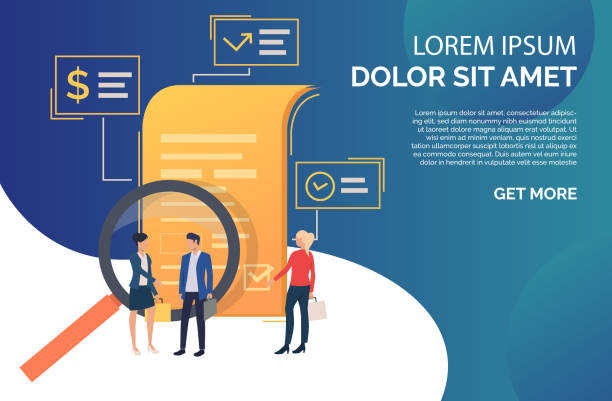The Unparalleled Importance of Fast Website Design in Today’s Digital World

In the age of information and communication, #website loading speed is no longer a competitive advantage but an undeniable necessity.
Internet users have high expectations from websites and will immediately leave a page if they encounter delays.
This not only harms the user experience (UX) but also directly impacts your SEO and website ranking in search engines.
Fast website design means building a website that displays information to the user in the shortest possible time and prevents excessive resource loading.
This process includes a set of techniques and strategies, from optimizing code and images to choosing suitable hosting and using Content Delivery Networks (CDNs).
With increasing online competition, every millisecond counts.
Did you know that even a one-second delay in loading can reduce conversion rates by up to 7%? This statistic clearly shows how vital investing in fast website design is.
This section provides a general educational and explanatory overview of what speed is and why it’s important on the web, setting the stage for more specialized discussions.
Does your company’s website perform as it should for your brand? In today’s competitive world, your website is your most important online tool. Rasaweb, specialists in professional corporate website design, helps you to:
✅ Build customer credibility and trust
✅ Convert website visitors into customers
⚡ Get a free consultation!
The Impact of Website Speed on SEO and User Experience

#Website loading speed is a critical factor in search engine ranking algorithms, especially Google’s.
For years, Google has explicitly stated that site speed is one of the important signals for page ranking.
This is because search engines aim to provide the best possible experience to their users, and a slow website will result in an unpleasant experience.
However, the #effects of speed are not limited to SEO alone.
User Experience (UX) is also heavily influenced by loading speed.
Modern users are impatient, and in today’s world where time is gold, they expect web pages to load almost instantly.
A fast-loading website not only has a lower Bounce Rate but also leads to a higher Conversion Rate.
In other words, users spend more time on your site, view more pages, and are more likely to take your desired action (such as purchasing a product or filling out a form).
This comprehensive analysis examines the strategic importance of fast website design from the perspective of SEO and user experience, demonstrating why this factor should not be overlooked.
Key Factors Affecting Website Design Speed

To achieve a #fast website design, understanding the factors affecting loading speed is essential.
These factors encompass a wide range of technical and non-technical issues.
One of the most important is #code optimization.
Disorganized code, excessive or unoptimized JavaScript and CSS, can severely reduce loading speed.
The next factor is #image and media size.
High-volume images and videos without proper compression are considered primary causes of site slowness.
Also, #server configuration and hosting type play a significant role; a weak server or unsuitable shared hosting can be a speed bottleneck.
The number of extra plugins and scripts can also lead to heavy loading and site slowness.
Finally, #caching and the use of Content Delivery Networks (CDNs) are powerful tools for increasing speed.
This section, in a specialized and guiding manner, examines various factors and explains the main areas for fast website design.
| Factor | Description | Impact on Speed |
|---|---|---|
| Code Optimization (HTML, CSS, JS) | Remove redundant code, compression, combine files | Positive (Speed Increase) |
| Image Size and Format | Use optimized formats (WebP), lossless compression | Positive (Speed Increase) |
| Server and Hosting Configuration | Choose quality hosting, enable Gzip compression | Positive (Speed Increase) |
| Number and Quality of Plugins | Use essential and optimized plugins, remove unnecessary ones | Depends (Can be Negative or Positive) |
| Caching and CDN | Temporary content storage for faster loading on subsequent visits | Very Positive (Significant Speed Increase) |
Optimization Tools and Techniques for Fast Website Design

Achieving #fast website design requires the use of a set of advanced tools and techniques.
One of the first steps is #code file compression (HTML, CSS, JavaScript).
Tools like Minify and UglifyJS can significantly reduce the size of these files.
Using #browser and server caching is also crucial.
Caching allows the user’s browser to store a copy of site resources for faster loading on subsequent visits.
Additionally, #Content Delivery Networks (CDNs) like Cloudflare or Akamai, store your static site content on multiple servers worldwide, so content is delivered from the server closest to the user, reducing latency.
Database optimization, proper cleanup, and indexing are also highly important for dynamic websites.
Choosing modern image formats like WebP instead of JPEG or PNG can also reduce image size without significant loss of quality.
This section provides a practical and specialized guide to tools that can help you with fast website design.
Is your current e-commerce website design causing you to lose customers and sales?
Rasaweb is your solution with modern and user-friendly e-commerce website designs!
✅ Significant increase in conversion rates and sales
✅ Strong branding and building customer trust
⚡ Get a free e-commerce website design consultation from Rasaweb!
Responsive Design and Mobile-First Approach and Their Impact on Speed

In today’s world, where most web traffic comes from mobile devices, #responsive design and a mobile-first approach are no longer an option, but a necessity.
This approach means your website should be designed to provide a consistent user experience across all dimensions and devices, from desktops to tablets and smartphones.
But how does this contribute to fast website design? An optimized responsive design eliminates the need to maintain separate versions for each device and utilizes more optimized code and resources.
Moreover, when you use a mobile-first approach, the focus is by default on optimizing for devices with more limited resources.
This means #reducing overall page size, #lazy loading images and videos, and prioritizing core content.
Google also prioritizes mobile-first and responsive sites in its rankings.
The analysis provided in this section shows how a correct mobile-first approach can be the cornerstone of a fast and successful website design and also examines the challenges and opportunities of this approach.
This is a key guide for web developers and designers.
Optimizing Images and Media: A Big Step Towards Fast Website Design

Images and media files often constitute a significant portion of a web page’s size, and therefore, #optimizing them plays a vital role in #fast website design.
A high-volume image alone can cause severe loading slowness.
There are numerous techniques for optimization.
The first step is #image compression without noticeable loss of quality.
Using online tools or desktop software to reduce file size is essential.
The second step is choosing the #appropriate image format.
Formats like WebP are rapidly gaining popularity due to offering better compression with similar quality.
JPEG is recommended for photos and PNG for transparent images.
Third, using #appropriate dimensions.
Load images at the size they are actually displayed on the site, not larger.
Fourth, implementing #lazy loading for images and videos.
This technique ensures that media are only loaded when the user scrolls to them, not at the initial page entry.
This section, as an educational guide, discusses the details of media optimization to achieve a fast website design and provides tips to enhance your website’s performance.
Server-Side and Database Optimization for More Speed

After client-side optimization, #server-side and database optimization is the next step to achieve a #fast and stable website design.
Website loading speed is not limited to front-end code and images; server performance and its interaction with the database also play a key role.
One of the most important actions is #choosing suitable hosting.
Cloud hosting, Virtual Private Servers (VPS), or dedicated servers offer better performance compared to shared hosting.
#Proper web server configuration (such as Apache or Nginx), enabling Gzip compression, and using server-side caching modules (like Varnish Cache) can significantly increase server response speed.
Regarding the database, #query optimization, proper table indexing, and periodic cleanup of redundant data are of high importance.
Using techniques like Load Balancing to distribute the load among multiple servers can also improve scalability and speed in large websites.
This section expertly and descriptively examines these important aspects and provides solutions for improving server-side infrastructure for a fast website design.
| Technique | Description | Effect on Speed |
|---|---|---|
| Choosing Suitable Hosting | Using quality hosts (VPS, Dedicated, Cloud) | Increase base speed and stability |
| Web Server Configuration | Optimizing Apache/Nginx, enabling Gzip | Reduce server response time |
| Server-Side Caching | Using Varnish, Redis, Memcached for response caching | Reduce server load and increase speed |
| Database Optimization | Table indexing, query optimization, cleaning redundant data | Increase data retrieval speed |
| Using HTTP/2 or HTTP/3 | Newer protocols for faster data transfer | Reduce network overhead and increase parallelization |
The Role of Hosting and Infrastructure in Fast and Efficient Website Design

Often overlooked, but the #role of hosting and infrastructure in #fast website design is pivotal.
No matter how optimized your site’s code is or how compressed its images are, if the server hosting the site is slow or inefficient, all efforts will be futile.
Hosting acts as the foundation of your website.
Choosing high-quality hosting with suitable hardware, sufficient bandwidth, and strong support is the first step in ensuring speed.
Shared Hosting is usually the cheapest option but can severely reduce your site’s speed due to limited resources and sharing with other sites.
In contrast, Virtual Private Servers (VPS), Dedicated Servers, and especially Cloud Hosting, offer greater control, dedicated resources, and higher scalability, which are essential for a fast website design and handling high traffic.
This section, as a #guide and educational piece, helps you understand the importance of choosing the right infrastructure and make the best decision for your website.
Did you know that 85% of customers check your company’s website before any interaction?
With Rasaweb, build a corporate website worthy of your reputation.
✅ Increase customer credibility and trust
✅ Attract high-quality leads
⚡ Get a free website design consultation
Continuous Monitoring and Maintenance to Preserve Site Speed

Achieving a #fast website design is not the end of the road; maintaining this speed requires #continuous monitoring and optimization.
Websites are living entities that, over time, with the addition of new content, fresh plugins, and traffic changes, may experience a decrease in speed.
Using tools like Google PageSpeed Insights, GTmetrix, and Pingdom is crucial for periodic speed checks and identifying bottlenecks.
These tools provide detailed reports on site performance and offer suggestions for improvement.
Additionally, #checking server logs to identify errors or slow requests, and #regularly updating the Content Management System (CMS), themes, and plugins can prevent potential problems.
Database optimization and clearing cache files should also be done periodically.
This analytical and guiding approach ensures that your website always operates at optimal speed and provides a positive user experience.
A fast website is always evolving and requires constant care to remain at its peak as a fast website design.
Where is the Future of Faster Website Design Heading?

As technology rapidly advances, the #future of fast website design is also evolving.
Beyond current techniques, new innovations are on the horizon that can revolutionize the web experience.
One of the most important is #HTTP/3 protocol, built on QUIC, which significantly increases the speed and security of web communications.
This protocol replaces HTTP/2 and resolves its issues in slow or unstable connections.
Also, #advancements in Progressive Web Apps (PWAs) and Accelerated Mobile Pages (AMP) technologies mean app-like user experience and instant page loading on mobile.
#Artificial intelligence and machine learning can also play a role in automated website optimization, from image recognition to predicting user behavior for content loading.
The concept of Edge Computing, which brings data processing closer to the end-user, also promises further reduction in latency and loading speed.
This section, as #news and #thought-provoking content, examines future trends in fast website design and provides a vision of the future web that will be even faster, more responsive, and more interactive than today.
Are you ready for these changes?
Frequently Asked Questions
| Question | Answer |
|---|---|
| What is fast website design? | A process for building a website that loads at high speed and provides a smooth and optimized user experience. |
| Why is website speed important? | Increased user satisfaction, improved search engine ranking (SEO), reduced bounce rate, and increased conversion rate. |
| What factors affect website speed? | Page size, number of HTTP requests, image optimization, JavaScript and CSS codes, server speed, and cache usage. |
| How can website speed be measured? | Using tools like Google PageSpeed Insights, GTmetrix, Pingdom Tools. |
| How can website speed be increased? | Optimizing images, compressing files (CSS, JS, HTML), browser caching, reducing redirects, choosing suitable hosting. |
| Does fast website design mean low quality? | No, fast design means designing with a focus on speed and efficiency optimization, not reducing the quality of design or content. |
| What is the role of hosting in website speed? | The speed and quality of the hosting server directly impact the site’s response time and consequently, loading speed. |
| How can images be optimized for speed? | Using appropriate formats (like WebP), compressing images without significant quality loss, defining specific dimensions for images. |
| Can complex websites also be fast? | Yes, by using appropriate architecture, code optimization, and resource management, even complex sites can have high speed. |
| Is fast website design the same as Agile development? | No, fast website design focuses on the final outcome (a fast website), while Agile development is a methodology for project management and software development. |
And other services of Rasaweb Advertising Agency in the field of advertising
- Smart Direct Marketing: Designed for businesses looking to improve SEO ranking through custom programming.
- Smart SEO: An effective tool to increase sales using real data.
- Smart Link Building: A combination of creativity and technology to improve SEO ranking through a data-driven content strategy.
- Smart Sales Automation: A creative platform to improve website traffic increase by managing Google Ads.
- Smart Social Media: Professional optimization to increase click-through rates using precise audience targeting.
And over a hundred other services in the field of internet advertising, advertising consultation, and organizational solutions.
Internet Advertising | Advertising Strategy | Advertorials
Resources
Secrets of Speed Optimization in Fast and Efficient Website DesignSecrets of Speed Optimization in Fast and Efficient Website DesignSecrets of Speed Optimization in Fast and Efficient Website DesignSecrets of Speed Optimization in Fast and Efficient Website Design
? For your business to grow and shine in the online space, Rasaweb Afarin Digital Marketing Agency is by your side, offering the best services. To enhance your digital presence and learn more about our solutions, including our professional personal website design services, please visit.
📍 Tehran, Mirdamad Street, next to Bank Markazi, Kazeroun Jonoubi Alley, Ramin Alley, No. 6



